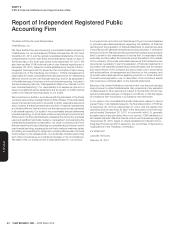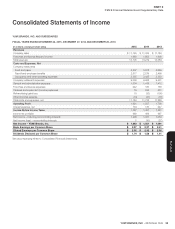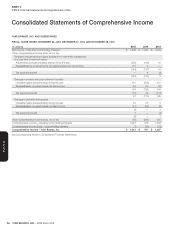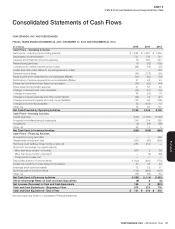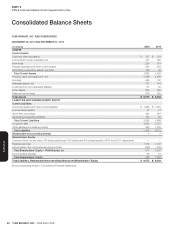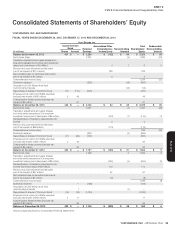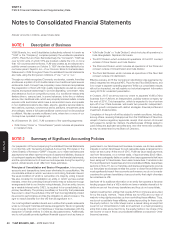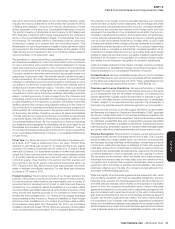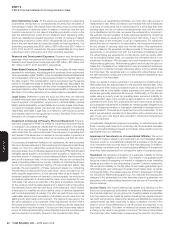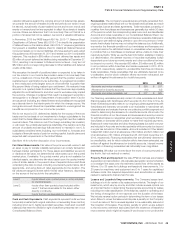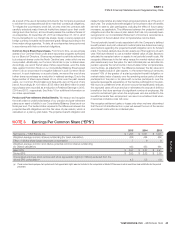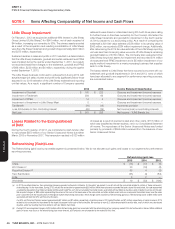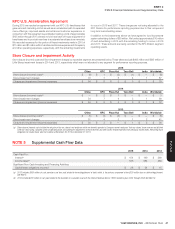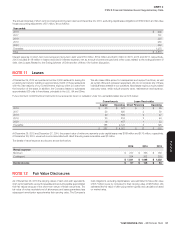Pizza Hut 2015 Annual Report Download - page 151
Download and view the complete annual report
Please find page 151 of the 2015 Pizza Hut annual report below. You can navigate through the pages in the report by either clicking on the pages listed below, or by using the keyword search tool below to find specific information within the annual report.
YUM! BRANDS, INC.-2015 Form10-K 43
Form 10-K
PART II
ITEM 8Financial Statements and Supplementary Data
valuation allowance against the carrying amount of deferred tax assets,
we consider the amount of taxable income and periods over which it must
be earned, actual levels of past taxable income and known trends and
events or transactions that are expected to affect future levels of taxable
income. Where we determine that it is more likely than not that all or a
portion of an asset will not be realized, we record a valuation allowance.
In November, 2015 the FASB issued ASU No. 2015-17, Balance Sheet
Classification of Deferred Taxes (ASU 2015-17) to simplify the presentation
of deferred taxes on the balance sheet. ASU 2015-17 requires organizations
that present a classified balance sheet to classify all deferred taxes as
noncurrent assets or noncurrent liabilities. We have elected to early adopt
this guidance as of December 26, 2015 and restate our 2014 comparable
balances. This resulted in $93 million of current deferred tax assets and
$2million of current deferred tax liabilities being reclassified at December27,
2014, resulting in an increase to Deferred income taxes – long term of
$82 million and a corresponding decrease to Other liabilities and deferred
credits of $9 million.
We recognize the benefit of positions taken or expected to be taken in
our tax returns in our Income tax provision when it is more likely than
not (i.e. a likelihood of more than fifty percent) that the position would be
sustained upon examination by tax authorities. A recognized tax position
is then measured at the largest amount of benefit that is greater than
fifty percent likely of being realized upon settlement. We evaluate these
amounts on a quarterly basis to ensure that they have been appropriately
adjusted for audit settlements and other events we believe may impact
the outcome. Changes in judgment that result in subsequent recognition,
derecognition or a change in measurement of a tax position taken in a prior
annual period (including any related interest and penalties) are recognized
as a discrete item in the interim period in which the change occurs. We
recognize accrued interest and penalties related to unrecognized tax
benefits as components of our Income tax provision.
We do not record a U.S. deferred tax liability for the excess of the book
basis over the tax basis of our investments in foreign subsidiaries to the
extent that the basis difference results from earnings that meet the indefinite
reversal criteria. This criteria is met if the foreign subsidiary has invested,
or will invest, the undistributed earnings indefinitely. The decision as to the
amount of undistributed earnings that we intend to maintain in non-U.S.
subsidiaries considers items including, but not limited to, forecasts and
budgets of financial needs of cash for working capital, liquidity plans and
expected cash requirements in the United States.
See Note 16 for a further discussion of our income taxes.
Fair Value Measurements. Fair value is the price we would receive to sell
an asset or pay to transfer a liability (exit price) in an orderly transaction
between market participants. For those assets and liabilities we record
or disclose at fair value, we determine fair value based upon the quoted
market price, if available. If a quoted market price is not available for
identical assets, we determine fair value based upon the quoted market
price of similar assets or the present value of expected future cash flows
considering the risks involved, including counterparty performance risk if
appropriate, and using discount rates appropriate for the duration. The
fair values are assigned a level within the fair value hierarchy, depending
on the source of the inputs into the calculation.
Level 1 Inputs based upon quoted prices in active markets
for identical assets.
Level 2 Inputs other than quoted prices included within
Level 1 that are observable for the asset, either
directly or indirectly.
Level 3 Inputs that are unobservable for the asset.
Cash and Cash Equivalents. Cash equivalents represent funds we have
temporarily invested (with original maturities not exceeding three months),
including short-term, highly liquid debt securities. Cash and overdraft
balances that meet the criteria for right of setoff are presented net on our
Consolidated Balance Sheet.
Receivables. The Company’s receivables are primarily generated from
ongoing business relationships with our franchisees and licensees as a result
of franchise, license and lease agreements. Trade receivables consisting of
royalties from franchisees and licensees are generally due within 30 days
of the period in which the corresponding sales occur and are classified as
Accounts and notes receivable on our Consolidated Balance Sheet. Our
provision for uncollectible franchisee and licensee receivable balances is
based upon pre-defined aging criteria or upon the occurrence of other
events that indicate that we may not collect the balance due. Additionally,
we monitor the financial condition of our franchisees and licensees and
record provisions for estimated losses on receivables when we believe
it probable that our franchisees or licensees will be unable to make their
required payments. While we use the best information available in making
our determination, the ultimate recovery of recorded receivables is also
dependent upon future economic events and other conditions that may
be beyond our control. We recorded $6 million, $3 million and $2 million
in net provisions within Franchise and license expenses in 2015, 2014
and 2013, respectively, related to uncollectible franchise and license
trade receivables. Trade receivables that are ultimately deemed to be
uncollectible, and for which collection efforts have been exhausted, are
written off against the allowance for doubtful accounts.
2015 2014
Accounts and notes receivable $ 393 $ 337
Allowance for doubtful accounts (16) (12)
Accounts and notes receivable, net $ 377 $ 325
Our financing receivables primarily consist of notes receivables and direct
financing leases with franchisees which we enter into from time to time. As
these receivables primarily relate to our ongoing business agreements with
franchisees and licensees, we consider such receivables to have similar risk
characteristics and evaluate them as one collective portfolio segment and
class for determining the allowance for doubtful accounts. We monitor the
financial condition of our franchisees and licensees and record provisions
for estimated losses on receivables when we believe it is probable that our
franchisees or licensees will be unable to make their required payments.
Balances of notes receivable and direct financing leases due within one year
are included in Accounts and notes receivable while amounts due beyond
one year are included in Other assets. Amounts included in Other assets
totaled $23 million (net of an allowance of $4million) and $21 million (net
of an allowance of $1 million) at December26, 2015 and December27,
2014, respectively. Financing receivables that are ultimately deemed to
beuncollectible, and for which collection efforts have been exhausted, are
written off against the allowance for doubtful accounts. Interest income
recorded on financing receivables has historically been insignificant.
Inventories. We value our inventories at the lower of cost (computed on
the first-in, first-out method) or market.
Property, Plant and Equipment. We state PP&E at cost less accumulated
depreciation and amortization. We calculate depreciation and amortization
on a straight-line basis over the estimated useful lives of the assets as
follows: 5 to 25 years for buildings and leasehold improvements, 3 to
20 years for machinery and equipment and 3 to 7 years for capitalized
software costs. We suspend depreciation and amortization on assets
related to restaurants that are held for sale.
Leases and Leasehold Improvements. The Company leases land,
buildings or both for certain of its restaurants worldwide. The length of our
lease terms, which vary by country and often include renewal options, are
an important factor in determining the appropriate accounting for leases
including the initial classification of the lease as capital or operating and
the timing of recognition of rent expense over the duration of the lease.
We include renewal option periods in determining the term of our leases
when failure to renew the lease would impose a penalty on the Company
in such an amount that a renewal appears to be reasonably assured at
the inception of the lease. The primary penalty to which we are subject
is the economic detriment associated with the existence of leasehold
improvements which might be impaired if we choose not to continue the



